By Lavinia Plonka
California Style Magazine stares up at me from the coffee table in my hotel room. It features a parade of impossibly tall, thin women with sculpted faces and futuristic Barbie hairdos. Like the almost human androids in the movie Blade Runner, these women seem perfectly crafted facsimiles of various iterations of Venus. Which brings me to musing about creation, evolution and mythology.
Darwinism tells us that humans evolved over time. Mythology tells us that humans were crafted: from dirt, mud, clay, ashes, blood, spit and more. This reminds me of a childhood attempt to craft a city out of mud in my backyard. I was about four years old. No matter how I mounded the lumps, they kept looking like blobs instead of some fabled kingdom. In a moment of artistic inspiration, I went inside and took a few glasses from the kitchen, filled them with mud and began tapping out towers, condos, turrets, even a fortress. My architectural masterpiece would have been brilliant had I not tapped too hard with one of the glasses. It shattered in my hand, cutting me in several places. When I ran crying to the house, my Mother freaked out and started screaming. My city remained unfinished, and my architectural career was over, a memory forever etched in mud and blood.
The Mayan gods actually had to keep recreating humans because of poor choice of materials. First, the people they made out of mud dissolved in a flood. I can hear the gods now. “OK, who proposed the mud idea?” All the gods look down at their feet, which at the moment feel like clay.
“Harry thought it was a good idea.”
“Really Harry, what were you thinking?”
“Well, I knew the budget was tight, I was trying to get it done quickly.
It worked over in Mesopotamia.”
They then tried wood, but the humans burned up in a fire. They finally got it right by creating humans out of corn. This triggers a disturbing thought. What if we are indeed “Children of the Corn” (with apologies to Stephen King)? Perhaps that’s the reason that corn is currently taking over the world. Michael Pollan has proposed in his book, Botany of Desire that plants have been manipulating us all along, seducing us with beauty and nourishment to help them spread. Could Monsanto’s efforts to “craft” a new, powerful, invulnerable corn that will irrevocably alter our DNA (if we survive) be part of corn’s master plan? Just kidding. Sort of.
Back to crafting humans. Another prerequisite in many cultures’ mythology is that the gods create beautiful creatures, in fact like the gods themselves. In a Navajo story, the gods had issues with their handiwork. They had sloppily crafted people with animal teeth, claws instead of feet and to add insult to injury, these proto-humans smelled bad. A paleontologist’s delight!
Current AI technology is getting closer to crafting the androids we saw in Blade Runner, and in the TV shows Humans and Better Than Us. Yet all these celluloid androids really just want to be human, like Pinocchio. Simultaneously, we humans are moving more towards becoming . . . something else. The technology of limb and organ replacement is advancing rapidly. Scientists, theologians and philosophers are busy in their ivory towers discussing how many body parts can be replaced before one is no longer human. And why stop at simple replacement? What stands in the way of becoming superhuman? Why not include a super computer in the brain? How about hands that crush steel instead of merely being able to hit “send?” What about eye replacements that can see infrared, UV, night vision? Lungs that can breathe toxic air, stomachs that can digest myriad variations of corn? The possibilities are endless. Between enhancements and replacements, it is predicted that the human of 2030 will be unrecognizable to us. 2030! Perhaps unwittingly we are creating our own replacements.
Scientists have already created a “bionic man.” They have taken prosthetics and various organ replacements from around the world and constructed a creature, not functional yet, but getting close. Perhaps all he needs is a jolt of some kind, like Frankenstein’s monster, to walk the earth.
In Greek Mythology, Prometheus and Epimetheus were put in charge of creating humans. They used the creation material of choice: mud and clay. Prometheus assigned Epimetheus the task of giving the creatures of the earth their various qualities, such as swiftness, cunning, strength, fur, wings. Unfortunately, by the time he got to man Epimetheus had given all the good stuff out and there was none left for man. So Prometheus decided to make man stand upright as the gods did and then give them fire. Things didn’t go so well for Prometheus after that, but humans have been using fire for craft, both culinary and artistic, ever since.
A popular gangster saying regarding departure from earthly life is, “It’s time to meet your maker.” When that opportunity arrives for me, I’ll have a few design suggestions for the craftsperson responsible for making me that scientists have probably not considered.
My wish list:
Eyes on the back of my head.
Retractable, functional wings.
Removable arms so I can sleep
comfortably on my side.
Invisibility by choice.
A pouch like kangaroos have so I don’t have to always carry a purse.
A Daryl Hannah hairdo that never needs maintenance.
The question remains. If in the future, we have limitless options on not only how to be, but what to be, who will we be? Will the constructions of the future look towards us ordinary humans as their creators? Will un-enhanced humans be viewed with scorn and pity? Millions of years from now, will there be a whole new set of creation myths? From where I sit, it looks to be a brave, new world indeed.
Body language expert, Lavinia Plonka has taught The Feldenkrais Method for over 25 years.
For more information, visit her at laviniaplonka.com

